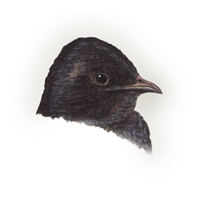|
Field
Guide IDs: BREEDING:
Open country,
savanna, rural areas, esp near water. 1-3
broods. DISPLAYS:
? NEST:
In tree hole, cliff
niche, or other cavity, often in birdhouse (esp in
e); of grass, leaves, mud, feathers, occ with dirt
rim to keep eggs from rolling out. EGGS:
White, unmarked.
1.0" (24 mm). DIET:
Occ feeds on ground
taking ants and other insects. CONSERVATION:
Winters in S.A. e
of Andes from Venezuela s to n Bolivia and se
Brazil. Blue List 1975-81, Special Concern 1982-86.
Forestry practice of removing standing dead trees
has greatly reduced availability of natural nest
sites; readily accepts colonial nest boxes.
Currently the focus of a concerted effort to locate
and monitor all active breeding
colonies. NOTES:
Usu. nest in
colonies. Occ polygynous. Often drinks and bathes
on the wing. Generally, very few birds return to
their natal colony to breed. House Sparrows and
starlings compete for nest cavities. Gather in
enormous premigratory communal roosts (up to
100,000 birds) at end of summer. ESSAYS: Blue
List;
Coloniality; Polygyny;
Communal
Roosting;
Bathing
and Dusting. REFERENCES:
Brown, 1979;
Finlay, 1976; Morton and Patterson,
1983. |
